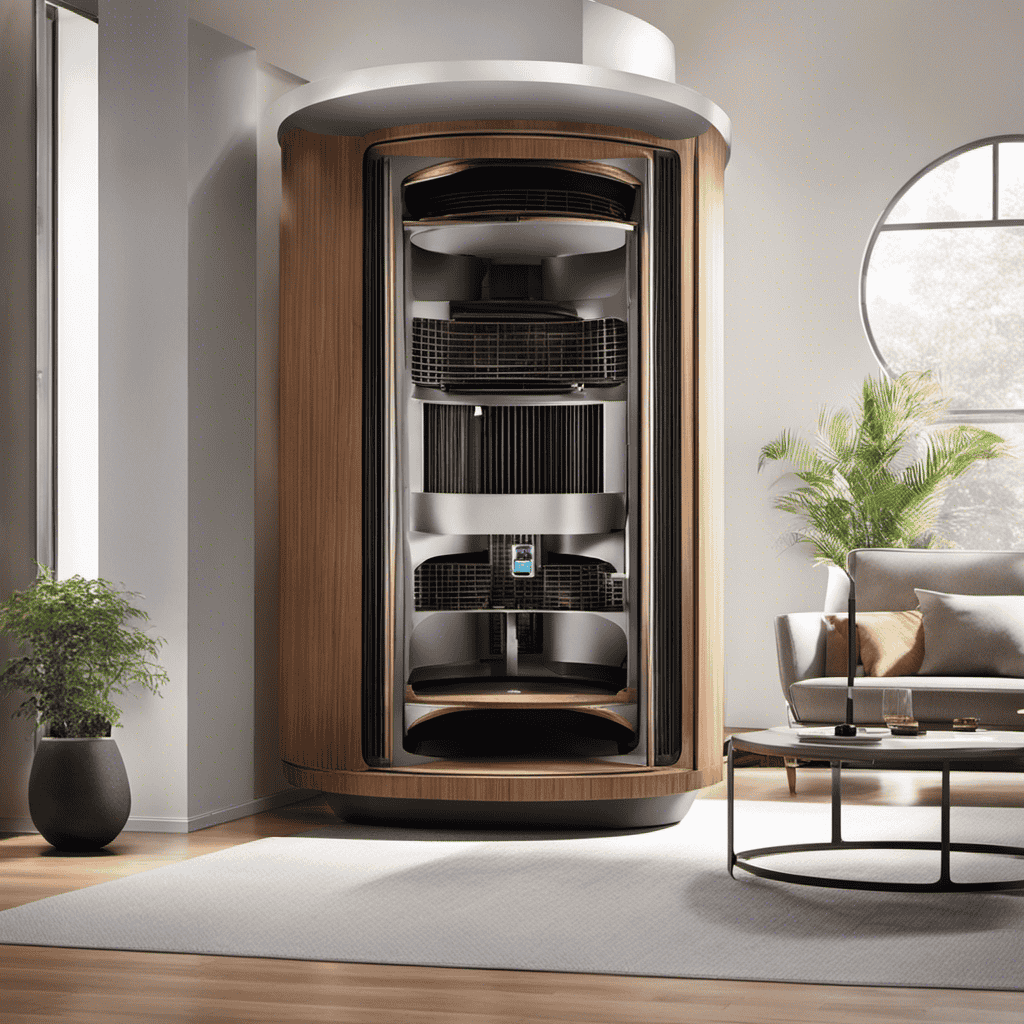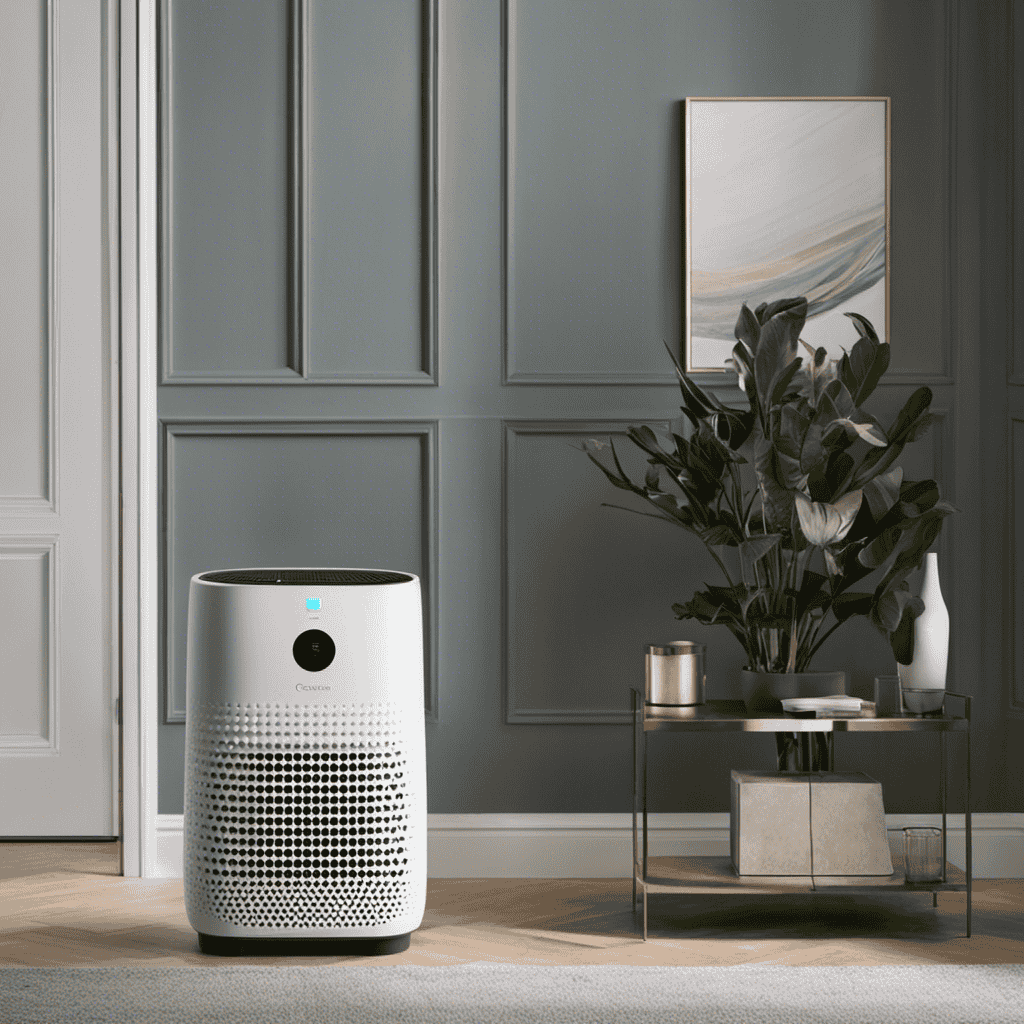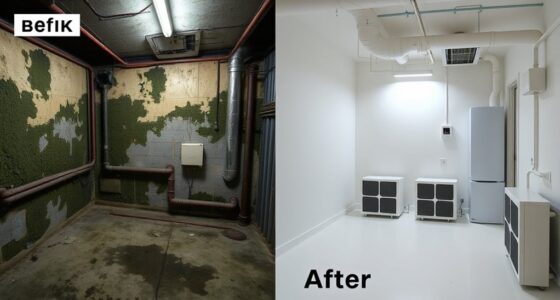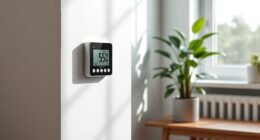Being a homeowner, I have always prioritized the air quality in my house. This is why I chose to purchase a whole house air purifier.
But how does it actually work? In this article, we’ll explore the ins and outs of whole house air purifiers, from understanding air filtration systems to the role of pre-filters and HEPA filters.
We’ll also delve into the importance of ionizers and provide tips for maintenance and cleaning.
So, if you’re curious about how to improve the air quality in your home, keep reading.
Key Takeaways
- Whole house air purifiers improve indoor air quality by removing pollutants and allergens.
- They utilize a combination of filters and air circulation systems.
- Different types of filters, such as HEPA filters, carbon filters, electrostatic filters, UV filters, and photocatalytic filters, are used to target specific pollutants.
- Regular maintenance, including filter replacement and cleaning, is necessary for optimal performance.
The Basics of Whole House Air Purifiers
You might be wondering how a whole house air purifier actually works. Well, let me break it down for you.
Whole house air purifiers are designed to improve indoor air quality by removing pollutants and allergens from the air. They work by utilizing a combination of filters and air circulation systems.
The air purifier draws in air from the house through a series of vents and ducts. This air then passes through a pre-filter that captures larger particles like dust and pet dander.
Next, the air moves through a high-efficiency particulate air (HEPA) filter that traps smaller particles such as pollen and mold spores. Finally, the purified air is released back into the house, providing cleaner and healthier air for the occupants.
The benefits of whole house purification include reduced allergies, improved respiratory health, and a cleaner living environment.
Understanding Air Filtration Systems
When it comes to understanding air filtration systems, it’s important to consider the types of filters and the purification mechanisms at play.
Different types of filters, such as HEPA filters, activated carbon filters, and UV filters, each have their own unique properties and capabilities.
Additionally, the purification mechanisms employed by these filters, such as physical filtration, chemical adsorption, and UV sterilization, work together to remove various pollutants and impurities from the air.
Types of Filters
To effectively filter the air in your home, consider the different types of filters available for whole house air purifiers. There are several types of purification technologies used in these filters, each with its own benefits and limitations. Here are some common types of filters you can choose from:
-
HEPA Filters: Highly efficient at capturing particles as small as 0.3 microns, removing allergens, dust, and pet dander.
-
Carbon Filters: Effective at removing odors, gases, and chemicals from the air.
-
Electrostatic Filters: Use static electricity to attract and trap particles, including smoke and microscopic allergens.
-
UV Filters: Utilize ultraviolet light to kill bacteria, viruses, and mold spores.
-
Photocatalytic Filters: Combine UV light with a catalyst to break down harmful pollutants like VOCs.
When considering filter efficiency, look for filters with a high MERV (Minimum Efficiency Reporting Value) rating. The higher the rating, the more particles the filter can capture.
It’s important to choose a filter that suits your specific needs and consider factors like filter replacement frequency and cost.
Purification Mechanisms
The different types of filters mentioned earlier, such as HEPA filters, carbon filters, electrostatic filters, UV filters, and photocatalytic filters, each employ various purification mechanisms to effectively clean the air in your home.
Air purifier technology has advanced significantly in recent years, providing homeowners with innovative solutions for improving indoor air quality.
HEPA filters, for example, work by trapping particles as small as 0.3 microns, removing common allergens like dust, pollen, and pet dander.
Carbon filters use activated carbon to absorb odors, chemicals, and volatile organic compounds (VOCs).
Electrostatic filters use an electrical charge to attract and capture particles.
UV filters utilize ultraviolet light to destroy bacteria and viruses.
Lastly, photocatalytic filters combine UV light with a catalyst to break down harmful pollutants.
The Components of a Whole House Air Purifier
When it comes to understanding the components of a whole house air purifier, there are a few key purification components that play a vital role in the system’s effectiveness.
These components include the pre-filter, HEPA filter, activated carbon filter, and UV-C light. Each of these components works together to remove different types of pollutants from the air, ensuring that the air in your home is clean and healthy to breathe.
In terms of the system installation process, it typically involves mounting the purifier unit near the HVAC system, connecting it to the air ducts, and ensuring proper electrical connections.
Key Purification Components
One of the key components in a whole house air purifier is the filter. The filter plays a crucial role in removing harmful particles and pollutants from the air, ensuring clean and fresh indoor air quality.
Here are five important purification components in a whole house air purifier:
-
Pre-filter: This initial stage filter captures larger particles like dust and pet hair, extending the lifespan of the main filter.
-
HEPA filter: High Efficiency Particulate Air (HEPA) filters are designed to trap microscopic particles as small as 0.3 microns, including allergens, bacteria, and viruses.
-
Activated carbon filter: This filter removes odors, chemicals, and volatile organic compounds (VOCs) from the air, improving the overall air quality.
-
UV-C light: Ultraviolet (UV) light helps to kill germs, bacteria, and viruses by disrupting their DNA and preventing them from reproducing.
-
Ionizer: An ionizer releases negatively charged ions into the air, which attach to airborne particles, making them heavier and easier to be captured by the filters.
The key purification components in a whole house air purifier provide numerous benefits, including cleaner air, reduced allergies, improved respiratory health, and a more comfortable living environment.
System Installation Process
Installing a whole house air purifier involves connecting it to the existing HVAC system.
The process starts by finding a suitable location for the purifier, typically near the air handler unit.
Next, the installer will connect the air purifier to the ductwork, ensuring a secure and airtight connection.
It is important to follow the manufacturer’s instructions and guidelines during the installation process to ensure proper functioning.
Once installed, the air purifier requires regular system maintenance to ensure optimal performance.
This includes cleaning or replacing filters, checking for any clogs or blockages, and inspecting the system for any signs of wear and tear.
In case of any issues, a troubleshooting guide provided by the manufacturer can be used to identify and fix common problems.
Regular system maintenance and following the troubleshooting guide are crucial for the air purifier to effectively remove contaminants from the air and maintain a healthy indoor environment.
How Does the Pre-filter Work
To understand how a whole house air purifier works, you’ll want to know how the pre-filter functions. The pre-filter is the first line of defense in the air purifier system. Its main purpose is to capture large particles such as dust, pet hair, and pollen, preventing them from entering the main filter. This pre-filter plays a crucial role in maintaining the efficiency of the air purifier and extending the lifespan of the main filter.
Here are the benefits of having a pre-filter in a whole house air purifier:
- Improved air quality: The pre-filter traps large particles, ensuring cleaner air for you and your family.
- Extended filter life: By capturing larger particles, the pre-filter prevents the main filter from getting clogged, leading to a longer lifespan for the entire system.
- Cost-effective: With a pre-filter in place, you won’t need to replace the main filter as frequently, saving you money in the long run.
- Easy maintenance: Cleaning or replacing the pre-filter is a simple task, making regular maintenance hassle-free.
- Enhanced performance: By removing larger particles, the pre-filter allows the main filter to focus on capturing smaller and more harmful particles, improving overall air purification efficiency.
Regular maintenance of the pre-filter is essential to ensure its effectiveness. Cleaning or replacing the pre-filter periodically, as recommended by the manufacturer, will help maintain the optimal performance of the air purifier system.
The Role of the HEPA Filter
If you want to improve the air quality in your home, you’ll be glad to know that the HEPA filter plays a crucial role in capturing smaller and more harmful particles.
HEPA, which stands for High-Efficiency Particulate Air, filters are designed to remove particles as small as 0.3 microns from the air. This makes them highly efficient in trapping allergens, dust, pet dander, and even some bacteria and viruses.
The efficiency of a HEPA filter is determined by its ability to capture particles of different sizes. The replacement of HEPA filters is essential to maintain their effectiveness.
Over time, as the filter gets clogged with particles, its efficiency decreases, and it becomes less effective at capturing harmful pollutants. It is recommended to replace HEPA filters every 6 to 12 months, depending on the air quality and usage.
Regular replacement ensures optimal air purification and maintains the performance of your air purifier.
Exploring Activated Carbon Filters
When it comes to air purifiers, understanding the effectiveness and longevity of carbon filters is crucial.
Carbon filters are known for their ability to remove odors, chemicals, and volatile organic compounds (VOCs) from the air.
However, their effectiveness can vary depending on factors such as the size of the filter, the quality of the carbon material used, and the airflow rate of the purifier.
Additionally, the longevity of carbon filters can also vary, with some filters needing to be replaced more frequently than others based on usage and the level of pollutants in the air.
Carbon Filter Effectiveness
The carbon filter in a whole house air purifier helps to effectively remove odors and harmful gases from the air. This is achieved through a process called adsorption, where the carbon filter’s porous structure traps and holds onto airborne particles. To ensure the carbon filter’s effectiveness, it is important to understand its lifespan and maintenance requirements.
Here are some key points to consider regarding carbon filter lifespan and maintenance:
-
Regular replacement: Carbon filters have a limited lifespan and need to be replaced periodically. The lifespan can vary depending on factors such as air quality and usage.
-
Filter monitoring: It is important to regularly monitor the carbon filter to determine when it needs to be replaced. Some air purifiers have indicator lights that signal when the filter needs changing.
-
Proper storage: When not in use, carbon filters should be stored in a cool, dry place to prevent degradation.
-
Cleaning: While carbon filters cannot be cleaned, it is important to clean the pre-filter regularly to prevent it from becoming clogged and reducing the effectiveness of the carbon filter.
-
Manufacturer’s recommendations: Always refer to the manufacturer’s guidelines for specific instructions on carbon filter maintenance and replacement.
Longevity of Carbon Filters
To maximize the lifespan of carbon filters, it’s important to follow the manufacturer’s recommendations for maintenance and replacement. Carbon filters are an essential component of air purifiers, as they effectively trap and remove harmful pollutants and odors from the air. However, over time, the carbon in these filters becomes saturated and loses its effectiveness. Regularly replacing carbon filters is crucial to ensure optimal performance and to maintain clean and healthy indoor air quality. By extending the filter lifespan, you can save money on replacements and ensure that your air purifier continues to function efficiently. Here is a table outlining the recommended maintenance and replacement schedule for carbon filters:
| Maintenance Task | Frequency |
|---|---|
| Vacuuming | Every 2 weeks |
| Washing | Every 3 months |
| Replacement | Every 6-12 months |
The Function of UV-C Lights in Air Purifiers
UV-C lights in air purifiers work by emitting ultraviolet light that helps in neutralizing and killing bacteria, viruses, and other harmful microorganisms in the air. These lights have several benefits and safety considerations that should be taken into account.
Some benefits of UV-C lights in air purifiers include:
- Effective germicidal properties that can help reduce the spread of infectious diseases.
- Ability to eliminate airborne allergens, such as pollen and mold spores.
- Continuous operation without the need for filter replacement.
- Compatibility with different types of air purifiers, making them versatile.
- Energy-efficient operation, consuming less electricity compared to other purification methods.
However, it is important to consider the safety aspects of UV-C lights in air purifiers:
- Direct exposure to UV-C light can be harmful to humans and should be avoided.
- Some air purifiers have safety mechanisms in place to prevent accidental exposure.
- Regular maintenance and cleaning of the UV-C light system is necessary to ensure optimal performance and safety.
- Proper installation and positioning of the air purifier are crucial to minimize human exposure to UV-C light.
- It is recommended to follow the manufacturer’s instructions and guidelines for safe and effective use of UV-C lights in air purifiers.
The Importance of Ionizers in Whole House Air Purifiers
In my previous subtopic, I discussed the function of UV-C lights in air purifiers. Now, let’s delve into the importance of ionizers in whole house air purifiers. Ionizers play a crucial role in improving indoor air quality by using the ionizing process to remove pollutants and allergens from the air. These devices emit negatively charged ions that attach to positively charged particles in the air, such as dust, pollen, and mold spores. The resulting ion clusters become too heavy to remain airborne and fall to the ground or are captured by the air purifier’s filters.
To highlight the benefits of ionizers, I have prepared a table showcasing their advantages:
| Benefits of Ionizers in Whole House Air Purifiers |
|---|
| Removes airborne pollutants and allergens |
| Neutralizes odors and harmful chemicals |
| Reduces the risk of respiratory illnesses |
| Enhances overall air quality and freshness |
Overall, the ionizing process used by ionizers is highly effective in improving indoor air quality and creating a healthier living environment.
Air Purifier Maintenance and Cleaning
Regular maintenance and cleaning are essential for ensuring the optimal performance and longevity of your air purifier. Neglecting these tasks can result in decreased efficiency and the accumulation of harmful pollutants.
To help you maintain your air purifier effectively, here are some essential maintenance tips and cleaning techniques:
- Replace filters regularly to prevent clogging and maintain air flow.
- Clean the exterior of the air purifier with a damp cloth to remove dust and debris.
- Use a vacuum cleaner with a brush attachment to clean the intake grills and vents.
- Clean the pre-filter regularly to prevent build-up of larger particles.
- Consider professional servicing to ensure thorough cleaning and inspection of internal components.
Benefits of Whole House Air Purifiers
After discussing the importance of maintaining and cleaning air purifiers, let’s now delve into the benefits of whole house air purifiers.
These systems are designed to remove airborne allergens and pet dander from your home, providing a cleaner and healthier environment for you and your family.
Whole house air purifiers are highly effective in reducing allergy symptoms caused by airborne particles, such as pollen, dust mites, and mold spores. They work by continuously circulating and filtering the air throughout your entire home, trapping these allergens and preventing them from recirculating.
In addition, these purifiers are particularly beneficial for pet owners. They can effectively remove pet dander, which is a common allergen that can trigger respiratory issues and allergies. By eliminating pet dander from the air, whole house air purifiers help create a more comfortable living space for both humans and pets.
Now that we understand the benefits of whole house air purifiers for allergies and pet dander, let’s move on to the next section, where we will discuss how to choose the right whole house air purifier for your home.
Choosing the Right Whole House Air Purifier for Your Home
Now that we’ve covered the benefits of whole house air purifiers, let’s explore how to choose the right one for your home.
When selecting a whole house air purifier, there are several factors to consider:
-
Size of your home: Determine the square footage of your house to ensure that the air purifier can effectively clean the entire space.
-
Filter type: Look for air purifiers with HEPA filters, as they are highly efficient in removing small particles and allergens from the air.
-
Airflow capacity: Consider the air exchange rate, which indicates how quickly the purifier can cycle the air in your home. A higher rate is preferable for more effective purification.
-
Noise level: Check the decibel rating of the air purifier to ensure it operates quietly, especially during nighttime.
-
Cost: Compare the prices of different models, considering not only the upfront cost but also the long-term expenses for filter replacements and energy consumption.
Conclusion
In conclusion, whole house air purifiers are a highly effective solution for improving indoor air quality. With their advanced filtration systems and innovative technology, these purifiers can remove a wide range of airborne pollutants and allergens, ensuring a healthier living environment.
One interesting statistic to note is that according to a study conducted by the Environmental Protection Agency (EPA), indoor air pollution levels can be 2 to 5 times higher than outdoor levels. This highlights the importance of investing in a whole house air purifier to protect our health and well-being.
With proper maintenance and regular cleaning, these purifiers can provide long-lasting benefits for your home and family. When choosing a whole house air purifier, it is crucial to consider factors such as your home’s size, the type of pollutants you want to target, and the purifier’s filtration efficiency.
By selecting the right purifier, you can enjoy cleaner and fresher air throughout your entire home.










